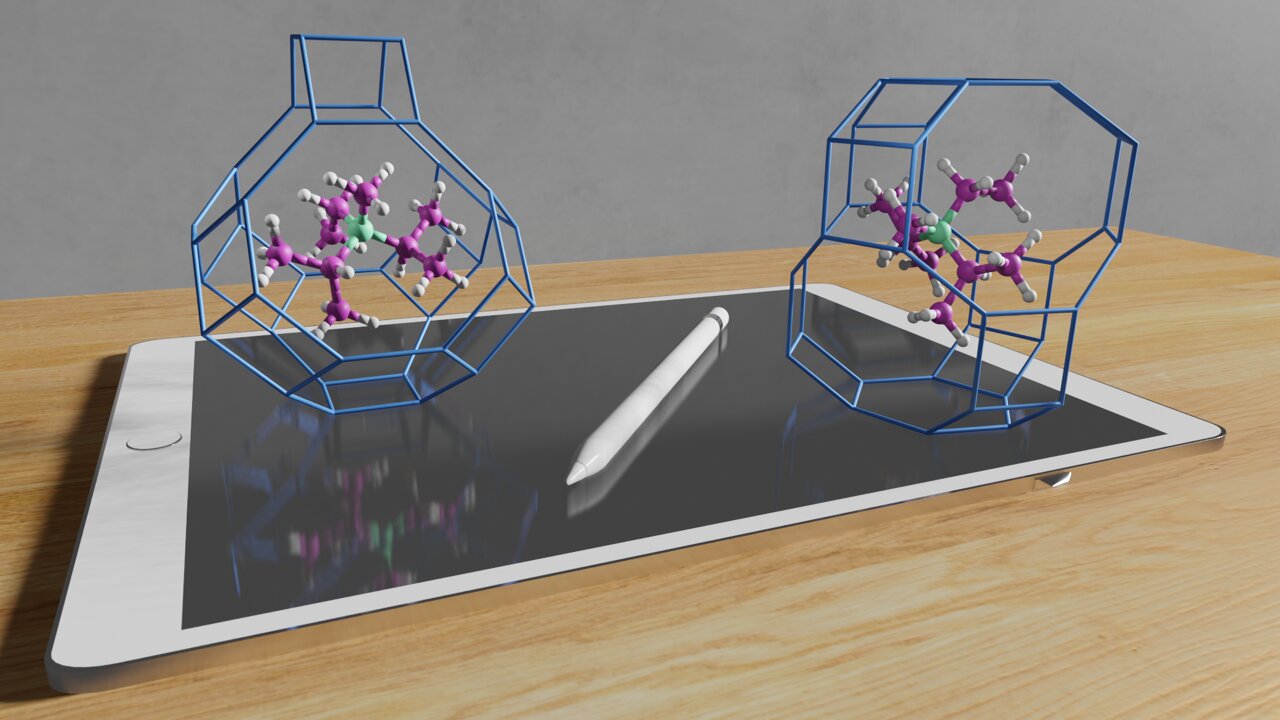[ad_1]
With the calculation method you can control the phase competition between the zeolite frameworks. The artist’s impression of how computer-designed molecules can synthesize two different scaffolds. Source: Schwalbe-Koda et al.
Zeolites, a group of minerals made up of hydrated aluminosilicates, are seen as promising materials for many applications. They can be used, for example, as catalysts, cation exchangers and molecular sieves.
Many previous studies have explored the potential of these materials, but so far Zeolite The synthesis has proven difficult and labor intensive. The term zeolite synthesis refers to the process by which zeolites can be made or synthesized in the laboratory.
Researchers at the Massachusetts Institute of Technology (MIT), in collaboration with researchers from the Polytechnic University of Valencia and Stockholm University, recently proposed a new strategy for controlling phase selectivity during the template-based zeolite synthesis process. This strategy chemistryBased on the combined use of atom simulation, literature search, human-computer interaction, synthesis and material characterization.
“Our research at MIT’s Learning Matter Lab is Materials scienceRafael Gomez-Bombarelli, one of the researchers who conducted the study, told Phys.org: … Still Atomic simulation Traditional approaches have helped in the past by focusing on one zeolite at a time, but the role of selectivity has been lacking. “
The calculation method enables the design of zeolite cavity templates. Source: Schwalbe-Koda et al.
Gomez-Bombarelli and colleagues used high-throughput simulations based on molecular mechanics to quantify the affinity of various molecular templates for both the zeolites they were trying to make and those that were unsuitable for a particular application. The team derived information from over 586,000 zeolite molecule simulations that are consistent with the existing material design literature.
“With these simulations we found the most selective template, even if it wasn’t the strongest binder,†another researcher involved in the study, Daniel Schwalbekoda, told Phys.org. “Thanks to fast algorithms that were refined in the previous year and compared with decades of literature data, simulations are orders of magnitude faster than conventional approaches and achieve many combinations very efficiently. Is finished. “
The results of the simulation have led to the identification of some possible designs of zeolites that could be realized in the future. While it is unclear whether all of the designs they identified are ideal, the work of Gomez-Bombarelli, Schwalbe-Koda, and colleagues limits the search for promising zeolite designs and speeds up the zeolite synthesis process. Can be useful for.
“The theory has usually supported experiments in zeolite research, but it rarely paved the way,” Manuel Moliner, one of the researchers who conducted the research, told Phys.org. “These new discoveries give us a much better chance of success when we start making new materials in the laboratory, a molecule that hasn’t received much attention but can generate new, efficient and inexpensive catalysts. Has a lot of untapped potential .. “

The phase competition was quantified for over 200 known zeolites and all literature. The results of the simulations allow researchers not only to find the right molecule for a particular scaffold, but also which scaffold is likely to crystallize when a particular molecule is used for synthesis. .. Source: Schwalbe-Koda et al.
This current study confirms that powerful computer tools and algorithms can play an important role in identifying new promising materials. Nevertheless, researchers firmly believe that expert intuition is still required when analyzing computer simulations and algorithmic predictions.
“After all, humans are the end users of the data, so we have to make them as useful as possible in real applications,†says Schwalbe-Koda. “One of my favorite findings in our study is that the shape of the molecule is a good predictor of selectivity. By using the traditionally used template of the intermediate form of the molecule. , You have created a new material that falls somewhere between the two known materials.
New computational strategies to control zeolite synthesis and structural composition presented by Gómez-Bombarelli, Schwalbe-Koda, Moliner and their colleagues could quickly help to discover new promising zeolite templates. This can have a significant impact on several research areas, such as the energy sector and climate change initiatives. Therefore, the researchers decided to publish the data. Interactive online website..
“There are many exciting ways into futurology,” says Moliner. “Two things of theoretical and practical interest come to mind: On the one hand, adapting the composition and shape of the zeolite catalyst pockets and moving on to ‘inorganic enzymes’. The other is to create a completely new zeolite that remains purely hypothetical for the time being. simulation We expect the data available to the community to encourage others to take new creative directions. â€
Daniel Schwalbe-Koda et al., Zeolite phase competition and precontrol of intergrowth through high throughput simulation, chemistry (2021). DOI: 10.1126 / science.abh3350
© 2021 Science X Network
Quote: Https: //phys.org/news/2021-09-strategy-phase-template-zeolite-synthesis.html Phase of the template zeolite synthesis (September 24, 2021) will receive strategies to control the selectivity on September 24, 2021
This document is subject to copyright. No part may be reproduced without written permission except in fair transaction for personal investigation or research purposes. The content is provided for informational purposes only.
Strategies for controlling phase selectivity in the synthesis of template zeolites
[ad_2]

